Samsung Epic 4G Review: The Fastest Android Phone
by Anand Lal Shimpi on September 6, 2010 5:28 PM EST- Posted in
- Smartphones
- Samsung
- Epic 4G
- Gadgets
- Mobile
Easily Influenced
As the manufacturer for both the NAND that goes into Apple devices and the SoC that Apple uses in the iPhone/iPad, Samsung works closer with Apple than most other smartphone vendors. I was once given a characterization of Samsung that I will never forget: this is a company that’s trying to learn as much as it can from Apple for use in its own smartphone endeavors.
There’s no better example than the Galaxy S. Unlike other vendors who have been Cupertino inspired, Samsung’s learnings are put to use almost exclusively in software. Physically, the Galaxy S is quite dissimilar from the industrial design used in Apple’s iOS products.
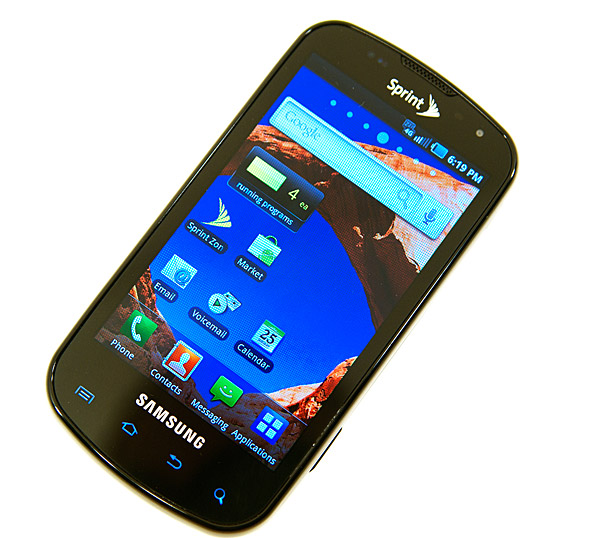
Samsung sent me the Epic 4G, a variant of the Galaxy S for use on Sprint’s network (with WiMAX support as implied by the 4G moniker). The Epic 4G has an amazingly contrasty 4” 800 x 480 Super AMOLED display. The capacitive touchscreen is backed up by a physical keyboard that slides out in landscape mode.
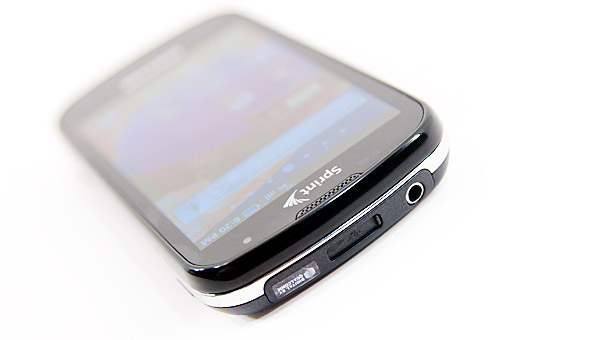
I’d say that Samsung did everything to be the most unlike Apple in the design of the Epic 4G. Along the top you have a microUSB port, but Samsung included a sliding cover to keep the pocket lint out. This adds complexity to the look of the device, but is nicely protective if you’re a bit OCD about getting lint in the crevices of your phone. The sheer location of the microUSB port is unusual as well. Most Android phones we’ve looked at have their power/sync connector at the bottom of the phone, not the top.
The power/lock button also shifts positions compared to what we’re used to. It’s on the right side, near the top on the Epic 4G.
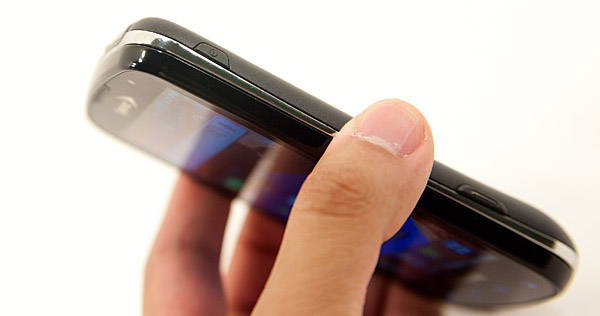
On the lower part of the right side of the phone there’s a shutter release button for the camera. There’s a volume rocker on the left side of the phone. All of the buttons on the Epic 4G have a rubbery texture to them with the exception of the shutter release button which has a metal insert surrounded by rubber.
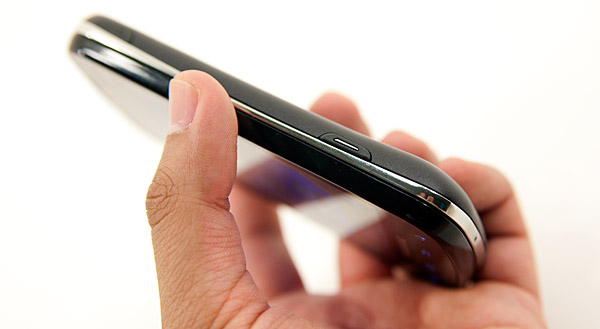
The screen slides up to reveal a landscape keyboard on the Epic 4G. The sliding mechanism is easy enough to operate with one hand and reasonably smooth. It’s not the most confidence inspiring but not terrible either.
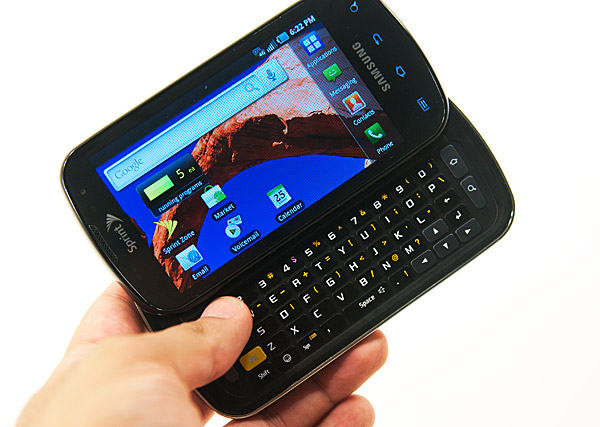
The physical keyboard itself is a nice addition for those who must absolutely have it. Samsung even duplicates the four Android keys on the keyboard itself (home, back, menu, and search) so you can exclusively use the physical keyboard for navigating the OS if you’d like. There is no scroll ball or equivalent on the Epic 4G, but the physical keyboard does have four arrow keys you can use in its stead.
The keys on the physical keyboard are fairly wide and reasonably spaced (it is a landscape keyboard after all). The keys are missing some curved definition that would make it easier to touch type on them but overall it’s not a bad keyboard. Again, not the best I’ve encountered but not terrible at all.
Since this is a slider phone, build quality isn’t the easiest to guarantee. The two halves of the phone independently feel well made, but the joining of the two isn’t super secure. The “oreo effect” as Brian likes to call it is very present on the Epic 4G. You can twist the top and bottom halves of the phone and get them to separate by a couple of degrees. It’s not terrible but if having a loose feeling phone bothers you then you may want to look elsewhere.

The four standard Android keys are also present in capacitive touch form along the bottom edge of the Epic 4G. Unlike most other Android phones, the capacitive buttons aren’t visibly outlined on the phone. You can only see them if they’re backlit, which has a timer associated with it that’s by default separate from the screen timer. What this means is that the row of Android buttons will actually disappear before the screen goes blank if you don’t touch the phone. Thankfully Samsung provides a setting to sync these two so both the screen and buttons go blank at the same time, but it’s just not enabled by default.
The Epic 4G is a good fit in my hand, but with a physical keyboard it is a thicker phone than most I’m used to. If you’re coming from a standard cellphone or feature phone, the Epic 4G is going to feel huge - if you’re coming from another Android/iOS device, it won’t be too bad.

From left to right: Google Nexus One, Samsung Epic 4G, iPhone 4
The phone is a mixture of materials, with the front being glossy plastic, then a chrome strip around the middle and a matte black back cover.
The back cover snaps off with relative ease revealing the 1500mAh battery, a microSD card slot and what looks like four external antenna connectors. I’m not really sure what the exposed connectors are for, perhaps to help during hardware testing/debug. Not having to take the battery out to get to the microSD card is a nice addition as well. The phone comes with a 16GB card as well as a microSD to SD card adapter for use in standard card readers.

Finally on the back we have a lens for the 5MP camera sensor and a single LED flash.
| Physical Comparison | |||||||||
| Apple iPhone 4 | Apple iPhone 3GS | Samsung Epic 4G | HTC EVO 4G | Motorola Droid X | |||||
| Height | 115.2 mm (4.5") | 115 mm (4.5") | 124 mm (4.9") | 121.9 mm (4.8") | 127.5 mm (5.02") | ||||
| Width | 58.6 mm (2.31") | 62.1 mm (2.44") | 63.5 mm (2.5") | 66.0 mm (2.6") | 66.5 mm (2.62") | ||||
| Depth | 9.3 mm ( 0.37") | 12.3 mm (0.48") | 15.2 mm (0.6") | 12.7 mm (0.5") | 9.9 mm (0.39") | ||||
| Weight | 137 g (4.8 oz) | 133 g (4.7 oz) | (5.47 oz) | 170 g (6.0 oz) | 155 g (5.47 oz) | ||||
| CPU | Apple A4 @ ~800MHz | Apple/Samsung A3 @ 600MHz | Samsung Hummingbird @ 1GHz | Qualcomm Scorpion @ 1GHz | TI OMAP 3630 @ 1GHz | ||||
| GPU | PowerVR SGX 535 | PowerVR SGX 535 | PowerVR SGX 540 | Adreno 200 | PowerVR SGX 530 | ||||
| RAM | 512MB LPDDR1 (?) | 256MB LPDDR1 | 512 MB LPDDR1 | 512MB LPDDR1 | 512MB LPDDR1 | ||||
| NAND | 16GB or 32GB integrated | 16 or 32GB integrated | 1 GB integrated, 16 GB microSD preinstalled | 1 GB integrated, 8 GB microSD preinstalled | 8 GB integrated, preinstalled 16 GB microSD | ||||
| Camera | 5MP with LED Flash + Front Facing Camera | 3MP with autofocus | 5 MP with LED Flash and autofocus | 8MP with dual LED Flash + Front Facing Camera | 8MP with dual LED Flash | ||||
| Screen | 3.5" 640 x 960 LED backlit LCD | 3.5" 320 x 480 | 4.0" 480 x 800 | 4.3" 480 x 800 | 4.3" 480 x 854 | ||||
| Battery | Integrated 5.254Whr | Integrated 4.51Whr | Removable 5.55Whr | Removable 5.5Whr | Removable 5.698 Whr | ||||










93 Comments
View All Comments
Dane74 - Monday, September 6, 2010 - link
My Epic is fine but the GPS is not, and the fixes out there for the other Galaxies are irrelevant to Epic, which has new, different, and in many ways, worse, GPS problems. Samsung has issued one single recommendation for the poor GPS on Epic: turn on cellular tower location estimates. Some fix!I am no iPhone fan. i can't stand them or the people who use them. But the GPS problems on the Epic are real. For starters look at the pics posted in this review. They are consistent with what anyone who tests the GPS finds -- the GPS reception hardware itself on Epic is weak. Look at that satellite strength.
Epic's other GPS problem is that frequent resets are required, as Epic does not discard expired GPS assistance data, and does not attempt to get new assistance data, often causing complete inability to get a GPS fix, even when many satellites are in view.
Desslok - Tuesday, September 7, 2010 - link
<b><q>I am no iPhone fan. i can't stand them or the people who use them...</b></q>WOW! Way to be an asshat of epic scale. Just because I have an iPhone you can't stand me? I thought only Apple users were supposed to be such arrogant asses?
medi01 - Tuesday, September 7, 2010 - link
I also can't stand you. In my opinion by agreeing to use hardware with unbelievably draconian restrictions (not being able to copy stuff from my own device? not being able to copy stuff to my own device from more than one source? ARE YOU KIDDING ME?), you are asking form even more crap in the future.Desslok - Tuesday, September 7, 2010 - link
Yet again the users on this site do not understand how most people use their phones and their way is the only way. Like bearxor has said in a later post most people take the phone out of the box and start using it. They don't root it and then start tweaking it.For what i use my phone for the iPhone works for me, am I saying it is the best phone/OS of all time of course not; it has it flaws. I am also not bashing anyone who uses any other type of phone/OS, It is a freakin phone/OS people it isn't that important.
Medi01-Hate if you want, but the iPhone works for me. Have fun judging others on material things, let me know how that works out for you in the future.
ktwebb - Tuesday, September 7, 2010 - link
I didn't say the GPS problems weren't valid. I just mentioned fixes were available. Multiple "Fixes" Unsatisfactory to ship their phones with broken GPS but that's Samsung. But once again, that's a hit on Samsung, not on the OS.bearxor - Monday, September 6, 2010 - link
Why does everyone on sites like this think their way is the only thing people will do. Do you really think a lot of people are going to buy a phone and then root it and then tweak it?No!
Most people are going to buy the phone, take it out of the box and begin using it. Heck, before switching to an iPhone in 2008, I used a Treo 700wx for two years, the longest I had ever used a WinMo device at a time, because I just got so sick and tired of HTC's crap. I was always having to reset the phone. Switch out ROMs on the phone. I never knew if a phone call was going to come through on a PPC-6600 or PPC-6700. Enough already!
I know that makes me less of a "geek" but I was cooking roms and flashing devices before a lot of people even discovered regular phones with qwerty keyboards on them.
I found this review to be a great example of what I would expect of the phone if I were to march down to a Sprint store, picked one up and started using it right away. That's all I really want from my phone. For it to do the functions that it's advertised to do.
nermie - Tuesday, September 7, 2010 - link
I think you also forget what website we are at. Just last a couple weeks ago there was an article on tuning your memory using a custom made bios. Every article on computer hardware usually covers the intended consumer point of view first, and then gets right into dissecting and tweaking the hardware to squeeze every last drop of performance out of it. Seems like kind of a shame to not at least mention how much faster the phone can be if you do a few things such as overclock the cpu or a file system fix.erple2 - Tuesday, September 7, 2010 - link
Normally, I'd completely agree with you. However, taking the phone as a complete package, I think that Anand has done a good job in reviewing the <i>phone</i> as you get it, and not post tweaking.While it may be common to buy a motherboard and CPU then tweak it until you squeeze the maximum amount of power out of it, it's less common to do that with a laptop.
Similarly, not very many people buy a Dell then go into overclocking options with it (since it's not necessarily as easy to do on a Dell than a home-assembled computer).
But I do agree that there's a myriad of things that can be done to the phone after the fact. I'd wager that it's possible Anandtech is coming up with a "Android tweaking" article at some point in the future that goes into some small detail of the things that are available to the end user, and how those can impact performance of the phone to the end user.
ktwebb - Tuesday, September 7, 2010 - link
That's fair. I've said in multiple posts Samsung blew it releasing this phone before properly QA testing. I think you missed my point however.dvinnen - Tuesday, September 7, 2010 - link
Don't like the fan boy accusations but he does bring up a point. With the lag fixes it does benchmark a lot faster (Look up One Click Lag Fix on the market, will root your phone and install the lag fix and GPS fix). Have to wonder how it will fly with 2.2